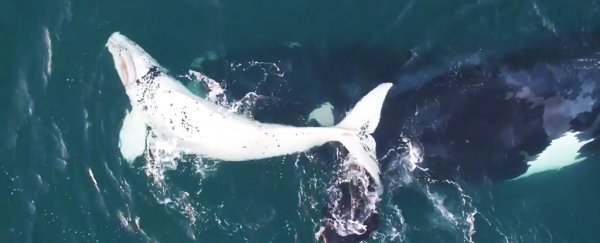
A team of whale watchers just uploaded some jaw-dropping drone footage of a rare white whale calf off the coast of Western Australia, giving scientists an invaluable, overhead look at the behaviour of these marine mammals.
If we can understand more about how southern right whales breed and grow, we could help to ensure that human activities aren't disrupting their natural environment.
"Little is known about the three-dimensional movements and habitat-use of southern right whales in their breeding and calving grounds in Australia – many of which are slated for development activity, including associated increases in shipping, marine tourism, and recreational activity," says one of the team, Lars Bejder, from Murdoch University in Australia.
"Our aim is not only to study the behavioural ecology of these amazing animals, but also to provide information to industry and management towards conservation."
A drone slowly buzzing overhead is a lot less disruptive than a boat full of scientists carrying cameras, giving a unique perspective on the whales in their natural habitat.
The aerial view also makes it easier for experts to get an idea of the size and the length of the whales they're observing.
To monitor the whales, the team is using a technology called digital acoustic recording tags (DTAGs), which feed back data on whale movement, sounds, calf suckling rates, and the acoustic environment, all at 800 samples per second.
These DTAGs were attached to the whales using handheld poles after the scientists were able to get close to them in a small vessel. The tags automatically detach from the whale after 24 hours.
"We need to know more about the ambient ocean noise in these regions and the extent to which southern right whales will be exposed to increased noise from human activity," says Bejder.
The southern right whale population is spread out all across the lower half of the southern hemisphere, covering the southern tips of Australia, South America, and Africa, and there are thought to be around 10,000 of them in the ocean in total.
Less than 5 percent of right whales are estimated to be born white, but they then turn black during the first year of life.
Calves are typically 5 to 6 metres long when born, and can reach up to 18 metres long – about 1.5 buses in length.
The name has an interesting origin as well. The animals were originally considered the 'right' whales to hunt, as they're not very fast in the water, they float to the surface when killed, and they have a lot of valuable substances inside them (including oil).
But after watching this clip, we're much happier they're now being left in peace.
